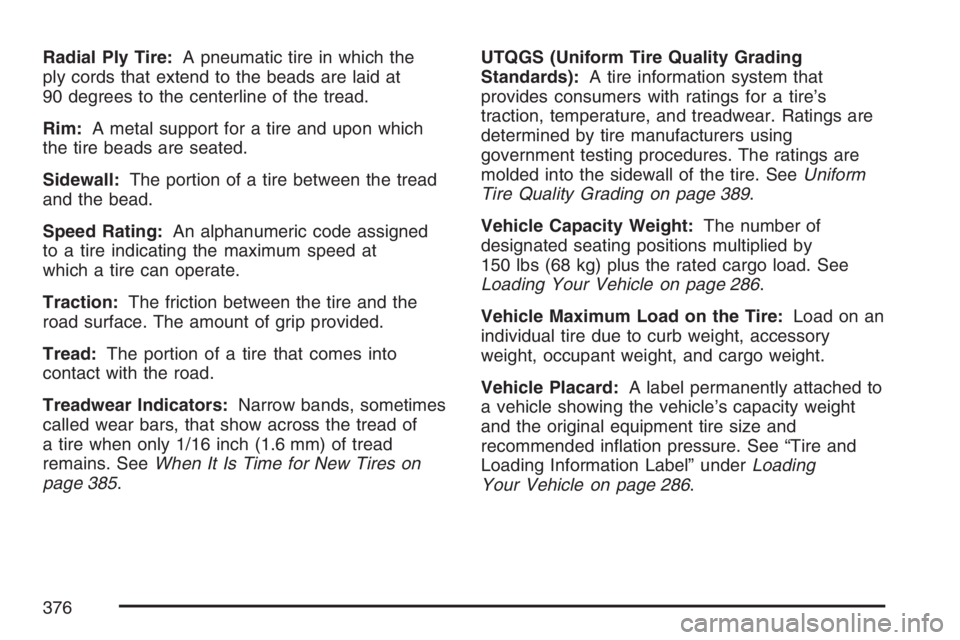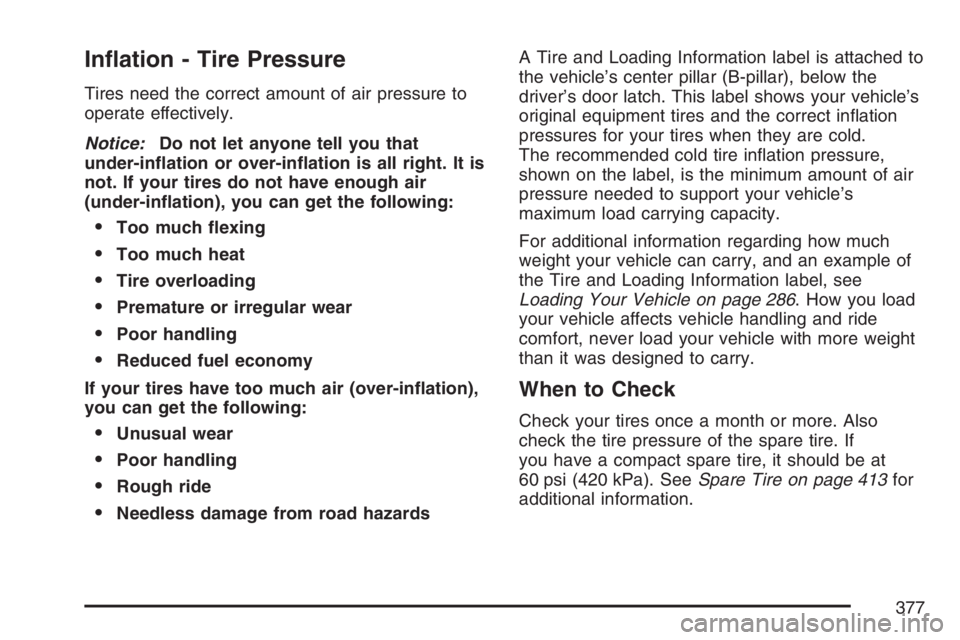2007 GMC CANYON tires
[x] Cancel search: tiresPage 314 of 492

Bulb Replacement....................................... 361
Halogen Bulbs........................................... 361
Headlamps................................................ 362
Front Turn Signal, Parking and
Daytime Running Lamps (DRL).............. 363
Center High-Mounted Stoplamp (CHMSL) ... 364
Taillamps, Turn Signal, Stoplamps and
Back-up Lamps...................................... 364
License Plate Lamp................................... 366
Replacement Bulbs................................... 366
Windshield Wiper Blade Replacement....... 367
Tires............................................................ 369
Tire Sidewall Labeling............................... 370
Tire Terminology and De�nitions............... 374
In�ation - Tire Pressure............................. 377
Tire Pressure Monitor System................... 378
Tire Inspection and Rotation...................... 383
When It Is Time for New Tires.................. 385
Buying New Tires...................................... 386
Different Size Tires and Wheels................ 388
Uniform Tire Quality Grading..................... 389
Wheel Alignment and Tire Balance............ 390
Wheel Replacement.................................. 390Tire Chains............................................... 392
If a Tire Goes Flat.................................... 393
Changing a Flat Tire................................. 394
Removing the Spare Tire and Tools.......... 395
Removing the Flat Tire and
Installing the Spare Tire......................... 398
Secondary Latch System........................... 406
Storing a Flat or Spare Tire and Tools...... 410
Spare Tire................................................. 413
Appearance Care........................................ 415
Cleaning the Inside of Your Vehicle.......... 415
Fabric/Carpet............................................. 416
Leather...................................................... 417
Instrument Panel, Vinyl, and
Other Plastic Surfaces........................... 418
Care of Safety Belts.................................. 418
Weatherstrips............................................ 418
Washing Your Vehicle............................... 419
Cleaning Exterior Lamps/Lenses................ 419
Finish Care............................................... 419
Windshield and Wiper Blades.................... 420
Aluminum or Chrome-Plated Wheels......... 421
Tires......................................................... 422
Section 5 Service and Appearance Care
314
Page 352 of 492

Brake Wear
Your vehicle has front disc brakes and rear
drum brakes.
Disc brake pads have built-in wear indicators that
make a high-pitched warning sound when the
brake pads are worn and new pads are needed.
The sound may come and go or be heard all
the time your vehicle is moving, except when you
are pushing on the brake pedal �rmly.
{CAUTION:
The brake wear warning sound means that
soon the brakes will not work well. That
could lead to an accident. When you hear
the brake wear warning sound, have your
vehicle serviced.
Notice:Continuing to drive with worn-out
brake pads could result in costly brake repair.
Some driving conditions or climates may cause
a brake squeal when the brakes are �rst applied or
lightly applied. This does not mean something is
wrong with the brakes.Properly torqued wheel nuts are necessary to help
prevent brake pulsation. When tires are rotated,
inspect brake pads for wear and evenly tighten
wheel nuts in the proper sequence to GM torque
speci�cations.
Rear drum brakes do not have wear indicators,
but if you ever hear a rear brake rubbing
noise, have the rear brake linings inspected
immediately. Also, the rear brake drums should be
removed and inspected each time the tires are
removed for rotation or changing. When you have
the front brake pads replaced, have the rear
brakes inspected, too.
Brake linings should always be replaced as
complete axle sets.
Brake Pedal Travel
See your dealer if the brake pedal does not return
to normal height, or if there is a rapid increase in
pedal travel. This could be a sign of brake trouble.
Brake Adjustment
Every time you make a brake stop, the brakes
adjust for wear.
352
Page 369 of 492

Tires
Your new vehicle comes with high-quality tires
made by a leading tire manufacturer. If you ever
have questions about your tire warranty and where
to obtain service, see your GM Warranty booklet
for details. For additional information refer to
the tire manufacturer’s booklet included with your
vehicle.
{CAUTION:
Poorly maintained and improperly used
tires are dangerous.
Overloading your vehicle’s tires can
cause overheating as a result of too
much friction. You could have an
air-out and a serious accident. See
Loading Your Vehicle on page 286.
CAUTION: (Continued)
CAUTION: (Continued)
Underin�ated tires pose the same
danger as overloaded tires. The
resulting accident could cause serious
injury. Check all tires frequently to
maintain the recommended pressure.
Tire pressure should be checked when
your vehicle’s tires are cold. See
Inflation - Tire Pressure on page 377.
Overin�ated tires are more likely to be
cut, punctured, or broken by a sudden
impact — such as when you hit a
pothole. Keep tires at the
recommended pressure.
Worn, old tires can cause accidents. If
the tire’s tread is badly worn, or if your
vehicle’s tires have been damaged,
replace them.
369
Page 370 of 492

Tire Sidewall Labeling
Useful information about a tire is molded into its
sidewall. The examples below show a typical
passenger vehicle tire and a compact spare tire
sidewall.(A) Tire Size:The tire size is a combination of
letters and numbers used to de�ne a particular
tire’s width, height, aspect ratio, construction type
and service description. See the “Tire Size”
illustration later in this section for more detail.
(B) TPC Spec (Tire Performance Criteria
Speci�cation):Original equipment tires designed
to GM’s speci�c tire performance criteria have
a TPC speci�cation code molded onto the sidewall.
GM’s TPC speci�cations meet or exceed all
federal safety guidelines.
(C) DOT (Department of Transportation):The
Department of Transportation (DOT) code
indicates that the tire is in compliance with the
U.S. Department of Transportation Motor Vehicle
Safety Standards.
(D) Tire Identi�cation Number (TIN):The letters
and numbers following DOT code are the Tire
Identi�cation Number (TIN). The TIN shows
the manufacturer and plant code, tire size, and
date the tire was manufactured. The TIN is molded
onto both sides of the tire, although only one
side may have the date of manufacture.
Passenger Vehicle Tire Example
370
Page 371 of 492

(E) Tire Ply Material:The type of cord and
number of plies in the sidewall and under the tread.
(F) Uniform Tire Quality Grading (UTQG):Tire
manufacturers are required to grade tires
based on three performance factors: treadwear,
traction and temperature resistance. For more
information seeUniform Tire Quality Grading on
page 389.
(G) Maximum Cold In�ation Load Limit:
Maximum load that can be carried and the
maximum pressure needed to support that load.
(A) Temporary Use Only:The compact spare
tire or temporary use tire has a tread life of
approximately 3,000 miles (5 000 km) and should
not be driven at speeds over 65 mph (105 km/h).
The compact spare tire is for emergency use when
a regular road tire has lost air and gone �at.
See “Compact Spare Tire” underSpare Tire on
page 413for additional information.
Compact Spare Tire Example
371
Page 372 of 492

(B) Tire Ply Material:The type of cord and
number of plies in the sidewall and under
the tread.
(C) Tire Identi�cation Number (TIN):The Tire
Identi�cation Number (TIN). The TIN shows
the manufacturer and plant code, tire size, and
date the tire was manufactured. The TIN is molded
onto both sides of the tire, although only one
side may have the date of manufacture.
(D) Maximum Cold In�ation Load Limit:
Maximum load that can be carried and the
maximum pressure needed to support that load.(E) Tire In�ation:The temporary use tire or
compact spare tire should be in�ated to 60 psi
(420 kPa). For more information on tire pressure
and in�ation seeIn�ation - Tire Pressure on
page 377.
(F) Tire Size:A combination of letters and
numbers de�ne a tire’s width, height, aspect ratio,
construction type and service description. The
letter T as the �rst character in the tire size means
the tire is for temporary use only.
(G) TPC Spec (Tire Performance Criteria
Speci�cation):Original equipment tires designed
to GM’s speci�c tire performance criteria have
a TPC speci�cation code molded onto the sidewall.
GM’s TPC speci�cations meet or exceed all
federal safety guidelines.
372
Page 376 of 492

Radial Ply Tire:A pneumatic tire in which the
ply cords that extend to the beads are laid at
90 degrees to the centerline of the tread.
Rim:A metal support for a tire and upon which
the tire beads are seated.
Sidewall:The portion of a tire between the tread
and the bead.
Speed Rating:An alphanumeric code assigned
to a tire indicating the maximum speed at
which a tire can operate.
Traction:The friction between the tire and the
road surface. The amount of grip provided.
Tread:The portion of a tire that comes into
contact with the road.
Treadwear Indicators:Narrow bands, sometimes
called wear bars, that show across the tread of
a tire when only 1/16 inch (1.6 mm) of tread
remains. SeeWhen It Is Time for New Tires on
page 385.UTQGS (Uniform Tire Quality Grading
Standards):A tire information system that
provides consumers with ratings for a tire’s
traction, temperature, and treadwear. Ratings are
determined by tire manufacturers using
government testing procedures. The ratings are
molded into the sidewall of the tire. SeeUniform
Tire Quality Grading on page 389.
Vehicle Capacity Weight:The number of
designated seating positions multiplied by
150 lbs (68 kg) plus the rated cargo load. See
Loading Your Vehicle on page 286.
Vehicle Maximum Load on the Tire:Load on an
individual tire due to curb weight, accessory
weight, occupant weight, and cargo weight.
Vehicle Placard:A label permanently attached to
a vehicle showing the vehicle’s capacity weight
and the original equipment tire size and
recommended in�ation pressure. See “Tire and
Loading Information Label” underLoading
Your Vehicle on page 286.
376
Page 377 of 492

In�ation - Tire Pressure
Tires need the correct amount of air pressure to
operate effectively.
Notice:Do not let anyone tell you that
under-in�ation or over-in�ation is all right. It is
not. If your tires do not have enough air
(under-in�ation), you can get the following:
Too much �exing
Too much heat
Tire overloading
Premature or irregular wear
Poor handling
Reduced fuel economy
If your tires have too much air (over-in�ation),
you can get the following:
Unusual wear
Poor handling
Rough ride
Needless damage from road hazardsA Tire and Loading Information label is attached to
the vehicle’s center pillar (B-pillar), below the
driver’s door latch. This label shows your vehicle’s
original equipment tires and the correct in�ation
pressures for your tires when they are cold.
The recommended cold tire in�ation pressure,
shown on the label, is the minimum amount of air
pressure needed to support your vehicle’s
maximum load carrying capacity.
For additional information regarding how much
weight your vehicle can carry, and an example of
the Tire and Loading Information label, see
Loading Your Vehicle on page 286. How you load
your vehicle affects vehicle handling and ride
comfort, never load your vehicle with more weight
than it was designed to carry.
When to Check
Check your tires once a month or more. Also
check the tire pressure of the spare tire. If
you have a compact spare tire, it should be at
60 psi (420 kPa). SeeSpare Tire on page 413for
additional information.
377